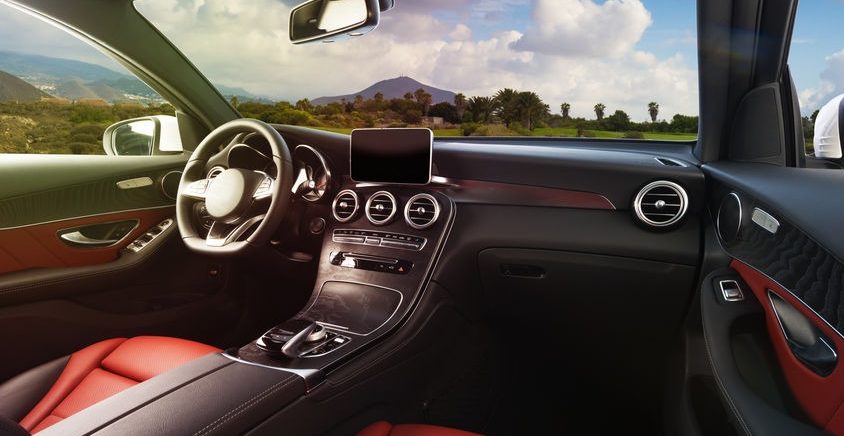As more and more vehicles are on the roads, cars of the future focus more and more on safety.
It's a focus that runs across all makes and models, but not every brand or design offers high-tech safety features. Volvo stands out for having made driving safety a core value back in 1927. Nearly a century later, they aspire to have no person harmed or killed in a new Volvo vehicle.
Here are some future (and existing) safety features from a range of brands and manufacturers.
- See-through pillars
The pillars on either side of the front windscreen may be transparent in times to come. Over the years, they've become wider to create a stronger framework that protects the passengers in the event of an accident. The downside is, it has widened the areas you can't see, otherwise known as your blind spots. "Transparent" pillars would solve this. The idea is to use cameras projecting onto an Organic Light Emitting Diodes (OLED) display (now you know what curving mobile screens want to be when they grow up). Continental is testing the new technology, but because these pillars are also used for internal airbag deployment, development is taking some serious design before it's a standard offering.
- External airbags
Airbags are coming out! You'll still have the internal airbags to cushion the impact on your body, but you'll also have ones to cushion the car. The ZF TRW external airbags prototype appeared at the CES show in 2019. When the car registers an imminent side impact, it deploys airbags from the outside of the vehicle. This not only reduces the impact on the passengers, it limits damage to the car itself. Win-win!
- Better voice control
You probably know Siri or other digital voice assistants that let you order your mobile around. Some are available for automobiles and they're increasingly smartly integrated into the safety functions of a car. Want your car to wake you up with a change of music when you're getting tired on the road? "BMW, please play me some serious trance right now". Oh, the lights brightened, too. And it's suddenly crisper inside, brrr… You're definitely awake now, all without removing your hands from the steering wheel or your eyes from the road. Ford, Toyota and Hyundai are all compatible with Alexa (Amazon's digital voice assistant). Want the boot opened before you leave the house? Done! If you integrate Echo (Amazon's digital voice assistant for the home), you can start the engine remotely or lock the doors you left unlocked when you came inside.
- Automatic emergency braking
One thing digital can do better than humans is crunch data. Fast. You have split seconds to choose whether or not to brake between seeing an obstacle in your path of movement on the road and hitting it; a digital automotive system has thousands of milliseconds to make the same call. With a "feature that alerts a driver to an imminent crash and helps them use the maximum braking capacity of the car," Volvo's City Safety will "alert the driver using a visual, acoustic and brake pulse warning to help him/her detect pedestrians, cyclists, larger animals and vehicles that suddenly appear" its website explains. This can prevent or reduce the force of the collision and is particularly useful when a driver responds too slowly. Think of it as a brake enhancer. Volvo's City Safety system works at slower speeds below 80km/h.
- Lane departure warning
Ever noticed yourself sliding a little over the white line when you're at the wheel and you're tired? This can quickly lead to serious accidents if you hit another car in the lane next to you. Lane Departure Warning is a safety feature that can prevent cars from bleeding across lanes unintentionally. Car safety leader, Volvo, has had a system that boasts two approaches since 2018. The Lane Departure Warning "alerts the driver with an acoustic signal or vibration in the steering wheel" and the Lane Keeping Aid "steers the car back into its lane and/or alerts the driver with an acoustic signal or vibration in the steering wheel." You're warned once for each instance that the wheels cross a line and their website goes on to point out that "lane assistance is merely a driver aid and does not engage in all driving situations or traffic, weather or road conditions. The driver always bears ultimate responsibility for ensuring that the vehicle is driven responsibly, and that applicable laws and road traffic regulations are followed." So, while the feature is still in its infancy, we can probably look forward to far smarter warnings and corrections as technology evolves and integrates more.
We know you're smart and ready for the automotive future, whatever safety features make it to market. Are your friends also ready, though? We'll reward you for helping them to be. If you're a dotsure.co.za motor policyholder and you refer a friend to also sign up for a motor policy with us, you will save big time on your next car insurance premium*. Simply follow this link to refer a buddy.
*T&Cs apply and are obtainable by emailing u2us@dotsure.co.za.
Read more:
Toyota gets techie, see how.
Check out this headset for your car!
Why not teach your car to drive?



